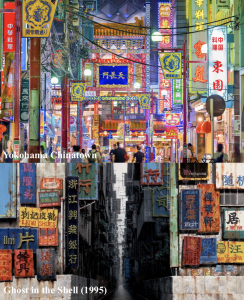
Darrell William Davis observes in his Technology and (Chinese) Ethnicity that Chinatowns in films have long been serving as stock backgrounds through which ‘jaded white heroes gather clues and chase villains,’ layered with unnoticeable Chinese niceties, of being mysterious and extraordinarily colorful. Chinatowns are also commonplace setting in cyberpunk films, as they were born with the Chinese culture and urban cyberculture. Locales are significant to the rendition of such cyberpunk films because they are powerful imageries that galvanize sentiments for both the protagonists and supporting characters.
The modern, glitzy enclave of post-industrial disarray depicted in Masamune Shirow’s Ghost in the Shell has contributed in blurring the representational ethnic ecology of a Chinatown. While pronounced as China-Town, the portmanteau instead refers to a modern settlement of various ethnicity, with the contemporary interpretation of Asian characteristics. The future cityscape in Ghost in the Shell successfully conserved the stereotypically-Chinese wet markets, the vibrant neon signboards, and Chinese Dai Pai Dongs (大排檔). Chinatown’s already-vulnerable state of identity crisis has been exacerbated by the completely defenseless personal identities. In the movie, individual identities of the characters ‘interchange’ with the surroundings, and their thoughts can be meddled and reproduced by the digital domain. When Major Kusanagi heard the murmuring of the sea, her mind was not hacked by the Puppet Master, but her thoughts were intertwined with the network which creates her ghost. The alphabet C in Chinatown equates to Confused, not China.
Chinatown is originally for Chinese immigrants majorly from Fujian and Canto as the portmanteau suggests. It comprises coastal China’s customs and architecture: the grand ancestral shrine and monuments, along with General Associations (Tongxianghui 同鄉會). However, the collective identity of Chinatown descendants has diminished, and has been replaced in Ghost in the Shell by informational identity motif. Ethnicity starred in Shirow’s film has defamiliarized the urban space of Hong Kong, its Chinatown-scape being different from the original. This can also be exemplified by Yokohama Chinatown, which currently is touted as a major tourist attraction that contributes to the Japanese tourism economy. Rather than a ‘static’ locale, it is a collage of enigmatic codes, fusion foods, and superstitions.
Chinatown has the potential to become a symbiosis of traditional architecture and amorphous identity, in response to the concurrent informational technology development trend. Concomitant to the insurgency of phobias against immigrants and advocacy for homogeneity in the established hegemonic countries, Chinatowns are relatively undisturbed by alt-right groups and rather welcomed. Such positivity towards Chinatowns amid globalization phobias perhaps is because of the absence of coherent and stringent ethnic identities Chinatowns.
By Lee Hae Jin (3035444176)